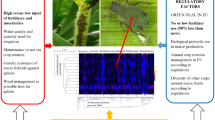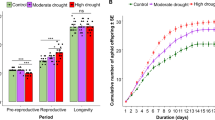Abstract
The effectiveness of the potato aphid,Macrosiphum euphorbiae (Thomas), to transmit potato virus Y (PVY) to potato has generally been overestimated because tobacco has been used as the indicator host. Our results demonstrate that, although apterousM. euphorbiae can acquire PVY from potato and tobacco plants and transmit it to tobacco plants, it does not readily transmit it to potato plants. Alatae only transmitted the virus to 4.5% of potato plants. This relative inability to transmit the virus to potato seems independent of potato cultivar. Results suggest that the role of the potato aphid in the spread of PVY in potatoes may be negligible.
Resumen
La efectividad del áfido,Macrosiphum euphorbiae (Thomas), para transmitir el virusY de la papa (PVY) a la misma, ha sido generalmente sobreestimada debido a que se ha utilizado tabaco como el huesped indicador. Nuestros resultados demuestran que a pesar de que las formas ápteras deM. euphorbiae pueden adquirir el PVY de las plantas de papa y tabaco, no lo transmiten fácilmente a las plantas de papa. Los individuos alados solo transmiten el virus al 4,5% de las plantas de papa. Esta inhabilidad para transmitir el virus a la papa parece ser independiente del cultivar de dicho cultivo. Los resultados sugieren que el rol del áfido de la papa en la diseminación del virusY en el cultivo, puede ser insignificante.
Similar content being viewed by others
Literature Cited
Bawden, F.C. and B. Kassanis. 1947. The behaviour of some naturally occurring strains of potato virus Y. Ann Appl Biol 34:503–516.
Beemster, A.B.R. and A. Rozendaal. 1972. Potato viruses: properties and symptoms. Pages 115–143.In: J. A. de Bokx (ed.). Viruses of potatoes and seed-potato production. Pudoc Wageningen. 233pp.
Boiteau, G. 1983. The arthropod fauna of potato fields: composition and seasonal abundance. Agriculture Canada, Contribution 1983-16E. 57 pp.
Bradley, R.H.E. and D.W. Rideout. 1953. Comparative transmission of potato virus Y by four aphid species that infest potato. Can J Zool 31:333–341.
Dykstra, T.P. and W.C. Whitaker. 1938. Experiments on the transmission of potato viruses by vectors. J Agric Res 57:319–334.
Harten, A. van. 1983. The relation between aphid flights and the spread of potato virus Yn (PVYn) in the Netherlands. Potato Res 26:1–15.
Hoof, H.A. van. 1980. Aphid vectors of potato virus Yn. Neth J P1 Pathol 86:159–162.
Kennedy, J.S., M.F. Day and V.F. Eastop. 1962. A conspectus of aphids as vectors of plant viruses. Commonwealth Agricultural Bureau, London. 114 pp.
MacGillivray, M.E. 1981. Aphids. Pages 101–103.In: W.J. Hooker(ed.). Compendium of potato diseases. American Phytopathological Soc, St. Paul, MN. 125 pp.
McKay, M.B. and T.P. Dykstra. 1932. Potato virus diseases. Oregon Investigations 1924- 1929. Oregon Agric Exp Stn Bulletin 294. 40 pp.
Proeseler, G. and H. Weidling. 1975. Die Retentionszeit von Stammen des Kartoffel-YVirus in verschiedenen Aphidenarten un Einflub der Temperatur. Arch Phytophathol u Pflanzenschutz 11:335–345.
Schultz, E.S. and D. Folsom. 1925. Infection and dissemination experiments with degeneration diseases of potatoes. J Agric Res 30:493–528.
Schultz, E.S., D. Folsom, F.M. Hilderbrandt and L.A. Hawkins. 1919. Investigations on the mosaic disease of the Irish potato. J Agric Res 17:247–274.
Shands, W.A., G.W. Simpson and H.E. Wave. 1972. Seasonal population trends and productiveness of the potato aphid on swamp rose in northeastern Maine. Maine Agric Exp Stn Tech Bull 52. 35 pp.
Simpson, G.W. 1940. Aphids and their relation to the field transmission of potato virus diseases in northeastern Maine. Maine Agric Exp Stn Bull 403. pp. 189–305.
Singh, R.P. and G. Boiteau. 1984. Necrotic lesion host for potato virus Y useful in field epidemiological studies. Plant Dis 68:779–781.
Singh, R.P. and J. Santos-Rojas, 1983. Detection of potato virus Y in primarily infected mature plants by ELISA, indicator host, and virus indexing. Can Plant Dis Surv 63:39–44.
Volk, Von J. 1959. Zur Ubertragung des Y-Virus durch Insekten und Kontakt. Zeit Pflanzenkrankh 66:563–571.
Watson, M.A. and F.M. Roberts. 1939. A comparative study of the transmission of Hyoscyamus virus 3, potato virus Y and cucumber virus 1 by the vectorsMyzus persicae (Sulz),M. circumflexus (Buckton), andMacrosiphum gei (Koch). Proc Royal Soc London Ser B 127:543–576.
Author information
Authors and Affiliations
Rights and permissions
About this article
Cite this article
Singh, R.P., Boiteau, G. Reevaluation of the potato aphid,Macrosiphum euphorbiae (Thomas), as vector of potato virus Y. American Potato Journal 63, 335–340 (1986). https://doi.org/10.1007/BF02854444
Accepted:
Issue Date:
DOI: https://doi.org/10.1007/BF02854444




